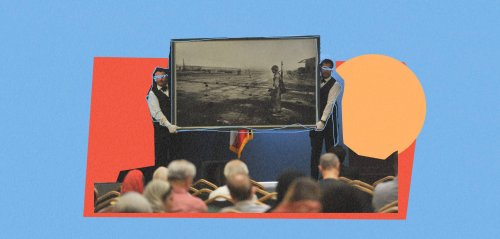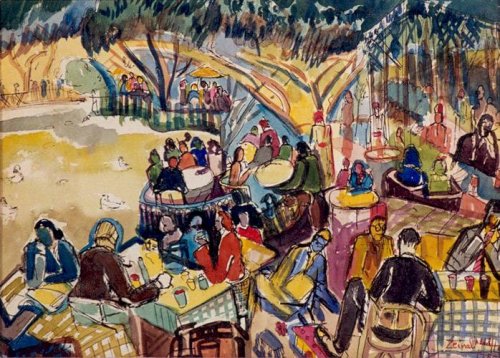When the global art scene was on the cusp of significant developments in the 1960s, Iran was experiencing a period of artistic disconnection, neglect, and international isolation following the triumph of the Islamic Revolution in 1979.
After two decades of this detachment, enforced by the new regime on the art scene and its practitioners, the reformist government (1997-2005) aimed to end the hiatus and reestablish connections with the world. They translated art books, welcomed international art magazines into the country, and hosted international art exhibitions within Iran, while Iranian artists actively participated in events and festivals around the world.
Through these endeavors, the Iranian art scene experienced a revival. However, over time, it became evident that the domestic art market was relatively modest, and Iranian artworks had limited value within the country. As a response, the Tehran Auction initiative was established.
 Tehran Auction
Tehran Auction
Tehran Auction
The Tehran Auction House recently concluded its 17th public auction of modern and contemporary Iranian artworks in 2023, with 100 out of the 110 participating artworks finding new owners.
You can view the Iranian artworks sold in the auction during the successive sessions through this link.
Before the establishment of Tehran Auction house in 2012, art owners would showcase their pieces in auctions worldwide. Since then, the auction has played a key role in reviving Iran's art economy and providing social and economic recognition to art collections
This year's auction set a remarkable record in sales compared to previous years, surpassing 213 billion tomans, equivalent to approximately 4.2 million dollars. Considering the current unfavorable exchange rate of the local currency against the dollar, this number is seen as a positive outcome for a local auction.
The artworks presented in this year's auction, held in July, featured pieces from a hundred Iranian artists, both within and outside the country, including prominent contemporary figures in the art market. Leading the pack was the renowned Iranian poet and painter, Sohrab Sepehri, whose paintings fetched the highest prices in the auction's history.
 A painting at Tehran Auction house
A painting at Tehran Auction house
A painting at Tehran Auction house
As always, Sepehri's paintings took the lead in sales. His untitled abstract landscape painting featuring a water pond, two red lily flowers, and half of a tree trunk achieved the highest bid in the auction. Another one of his paintings from a series depicting tree trunks secured the third position in terms of sales.
The Tehran Auction showcased around 86 paintings, 9 sculptures, 4 photographs, and 11 calligraphy artworks. The unprecedented economic crisis gripping the country did not stand in the way of the flourishing art trade, nor prevented affluent buyers from spending on valuable Iranian works of art.
The history of Tehran Auction
In the past, art owners used to showcase their pieces in auctions worldwide prior to the establishment of Tehran Auction in 2012. Since its inception, this auction has played a pivotal role in revitalizing the Iranian art economy, providing social and economic benefits to art collectors, even those residing abroad, by creating a national auction platform within the country.
Tehran Auction house, established by the private sector, has taken upon itself the responsibility of promoting the finest examples of modern, contemporary, and occasionally classical Iranian works of art.
 Tehran Auction
Tehran Auction
Tehran Auction
In addition to showcasing renowned artists and their works, the auction also fosters emerging talents, seeking to attract interest from domestic and international contemporary Iranian art enthusiasts, thereby offering them a chance to acquire exceptional works across various mediums.
During its first session in 2012, the auction successfully sold 73 artworks at a total cost that did not exceed one million dollars at the time. This marked a promising beginning for the public auction, which has now, after 11 years, earned a prestigious position among art enthusiasts.
What is being sold?
Tehran Auction features modern and contemporary visual arts, including paintings, sculptures, photographs, and calligraphy. Furthermore, it includes some works by masters of classical Iranian art, such as the legendary painter Kamal ol-Molk and his students and contemporaries, along with examples of paintings from that era. However, the auction strictly adheres to this classification and does not include any artworks or heritage items beyond these defined categories.
In the context of Tehran Auction, the term "classic art" refers to the works of the renowned artist Kamal ol-Molk (1847-1940) and his first-grade students and followers, who significantly contributed to breaking away from the traditional style of ancient Iranian painting and embraced modern art.
 A painting at Tehran Auction house
A painting at Tehran Auction house
Painting at Tehran Auction
Modern art in Iranian art history dates back to the 20th century, with its initial sparks igniting in the 1940s. At the time, Iranian artists endeavored to explore a new understanding of art and artistic expression in the era of modernity, embracing fresh concepts from contemporary art.
Tehran Auction house organizes an exhibition and a public auction twice a year. The first auction focuses on modern and classical works of art during the summer season, while the second auction showcases contemporary art during the winter season.
A distinctive aspect of Tehran Auction house is that it has omitted the buyer's commission from sales, in order to encourage more individuals and a broader audience to acquire works of art.
"We are not isolated from the world"
Tehran Auction was founded by the artist Ali-Reza Sami-Azar, a respected academic figure in the art world and former director of the Tehran Museum of Contemporary Art. He also serves as an expert at Christie's Dubai auction house, specializing in Middle Eastern art.
"We have entered a post-modern world, where everything, including art, is somewhat linked to economic issues. It's impossible to discuss cultural and artistic development when the monetary value of art remains low. Today's world has come to the conclusion that the value of art is clearly manifested in its market. The art market largely reflects the value that the history of art assigns to artists, and this value materializes as a record. This has been a global experience, and we are not isolated from the world. Therefore, the evolution of art in Iran is also subject to financial evaluation in these auctions and exhibitions." Ths was his response to critics of the Tehran Auction phenomenon, particularly from the conservative segment of artists and the community.
"Many who take part in the auction to acquire artwork have shifted away from showing off their cars on the streets, realizing that this has become embarrassing and childish. What they can genuinely take pride in is artistic, cultural, and spiritual enrichment"
Over the years of its establishment, Tehran Auction has garnered support from the moderate government under President Hassan Rouhani, which demonstrated a keen interest in nurturing the arts through an increase in art galleries, the establishment of art colleges, and a boost in the sales of art magazines. Alongside these developments, the society's understanding and perception of art underwent a transformation, recognizing the significance of both its material and spiritual aspects. Ali-Reza emphasizes, "Today, few still hold the notion that a truly talented artist must be impoverished."
While Tehran Auction has not been without its share of wealthy and affluent buyers, who sometimes acquire artworks merely for ostentation and display without a deep appreciation of the art and artists, the auction's director points out a remarkable change, saying, "Many of those who participate in the auction to acquire artworks have shifted away from ostentatiously showing off their cars on the streets. They have realized that what they used to boast about has become embarrassing and childish. Instead, they now take genuine pride in the cultural and spiritual enrichment brought about by their engagement with art. They recognize that the true worth lies in cherishing creativity, beauty, and the adept portrayal of human emotions."
The inception of Tehran Auction was inspired by the realization that Iranian artworks were being undervalued within the country while fetching exorbitant prices at Dubai's prestigious Christie's auction house. This raised concerns about the potential threat to the Iranian art market, as foreign clients flocked to Tehran to acquire masterpieces at a fraction of their global worth, only to resell them abroad. Consequently, the auction was established to bolster the local art market, elevating prices domestically to match international standards. Remarkably, the prices of artworks at Tehran Auction now surpass those achieved in auctions held in other countries.
Tehran Auction has successfully conveyed a message to art enthusiasts around the world, assuring them that Iranian art within the country commands a dedicated and discerning audience. This sends a resounding message that the Iranian art market can be relied upon as a credible and trustworthy source for remarkable artistic creations.
Raseef22 is a not for profit entity. Our focus is on quality journalism. Every contribution to the NasRaseef membership goes directly towards journalism production. We stand independent, not accepting corporate sponsorships, sponsored content or political funding.
Support our mission to keep Raseef22 available to all readers by clicking here!
Interested in writing with us? Check our pitch process here!









